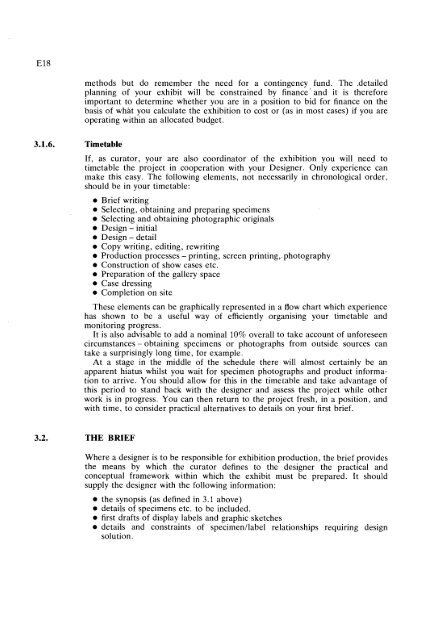GUIDELINES FOR THE CURATION OF GEOLOGICAL MATERIALS
GUIDELINES FOR THE CURATION OF GEOLOGICAL MATERIALS
GUIDELINES FOR THE CURATION OF GEOLOGICAL MATERIALS
Create successful ePaper yourself
Turn your PDF publications into a flip-book with our unique Google optimized e-Paper software.
methods but do remember the need for a contingency fund. The .detailed<br />
planning of your exhibit will be constrained by finance' and it is therefore<br />
important to determine whether you are in a position to bid for finance on the<br />
basis of what you calculate the exhibition to cost or (as in most cases) if you are<br />
operating within an allocated budget.<br />
Timetable<br />
If, as curator, your are also coordinator of the exhibition you will need to<br />
timetable the project in cooperation with your Designer. Only experience can<br />
make this easy. The following elements, not necessarily in chronological order,<br />
should be in your timetable:<br />
Brief writing<br />
Selecting, obtaining and preparing specimens<br />
Selecting and obtaining photographic originals<br />
Design - initial<br />
Design - detail<br />
Copy writing, editing, rewriting<br />
Production processes - printing, screen printing,.photography<br />
Construction of show cases etc.<br />
Preparation of the gallery space<br />
Case dressing<br />
Completion on site<br />
These elements can be graphically represented in a flow chart which experience<br />
has shown to be a useful way of efficiently organising your timetable and<br />
monitoring progress.<br />
It is also advisable to add a nominal 10% overall to take account of unforeseen<br />
circumstances - obtaining specimens or photographs from outside sources can<br />
take a surprisingly long time, for example.<br />
At a stage in the middle of the schedule there will almost certainly be an<br />
apparent hiatus whilst you wait for specimen photographs and product information<br />
to arrive. You should allow for this in the timerable and take advantage of<br />
this period to stand back with the designer and assess the project while other<br />
work is in progress. You can then return to the project fresh, in a position, and<br />
with time, to consider practical alternatives to details on your first brief.<br />
<strong>THE</strong> BRIEF<br />
Where a designer is to be responsible for exhibition production, the brief provides<br />
the means by which the curator defines to the designer the practical and<br />
conceptual framework within which the exhibit must be prepared. It should<br />
supply the designer with the following information:<br />
the synopsis (as defined in 3.1 above)<br />
details of specimens etc. to be included.<br />
first drafts of display labels and graphic sketches<br />
details and constraints of specimenllabel relationships requiring design<br />
solution.

















